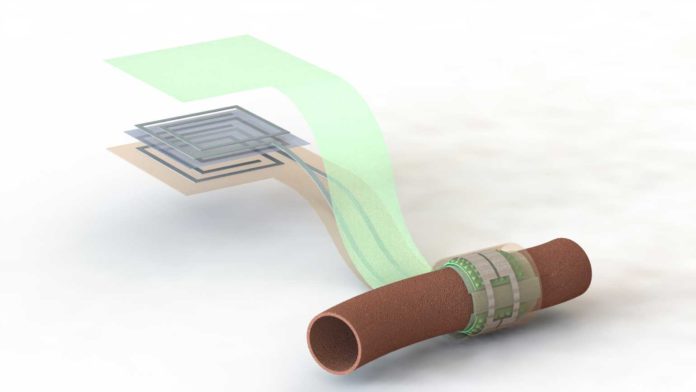Tracking the success of surgeries on veins is a challenging task as a first sign often takes time to come. By that time, the patient often needs to undergo an additional surgery that carries risks similar to the original procedure.
To make it easier to monitor the success of blood vessel surgery, Standford scientists have come up with a wireless, battery-free, biodegradable blood flow sensor that could let doctors keep tabs on a healing vessel from afar, creating opportunities for earlier interventions.
The sensor monitors the flow of blood through an artery. The sensor wraps snugly around the healing vessel, where blood pulsing past pushes on its inner surface. As the shape of that surface changes, it alters the sensor’s capacity to store electric charge, which doctors can detect remotely from a device located near the skin but outside the body. That device solicits a reading by pinging the antenna of the sensor, similar to an ID card scanner.
Paige Fox, assistant professor of surgery said, “Measurement of blood flow is critical in many medical specialties, so a wireless biodegradable sensor could impact multiple fields including vascular, transplant, reconstructive and cardiac surgery. As we attempt to care for patients throughout the Bay Area, Central Valley, California and beyond, this is a technology that will allow us to extend our care without requiring face-to-face visits or tests.”
Scientists primarily tested the sensor in an artificial setting where they pumped air through an artery-sized tube to mimic pulsing blood flow. Surgeon Yukitoshi Kaizawa, a former postdoctoral scholar at Stanford also implanted the sensor around an artery in a rat. The sensor successfully reported blood flow to the wireless reader. even at small scale.
Zhenan Bao said, “This one has a history. We were always interested in how we can utilize these kinds of sensors in medical applications but it took a while to find the right fit.”
Scientists made the sensor sensitive to pulsing blood but rigid enough to hold its shape. They also moved the antenna to a location where it would be secure, not affected by the pulsation, and re-design the capacitor so it could be placed around an artery.
Levent Beker, co-lead author of the paper said, “It was a very exacting project and required many rounds of experiments and redesign. I’ve always been interested in medical and implant applications and this could open up a lot of opportunities for monitoring or telemedicine for many surgical operations.”
The paper describing the study is published in the Nature Biomedical Engineering.
